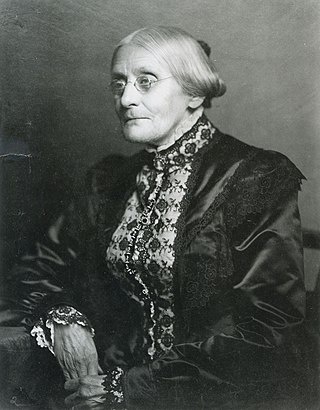
Susan B. Anthony was an American social reformer and women's rights activist who played a pivotal role in the women's suffrage movement. Born into a Quaker family committed to social equality, she collected anti-slavery petitions at the age of 17. In 1856, she became the New York state agent for the American Anti-Slavery Society.
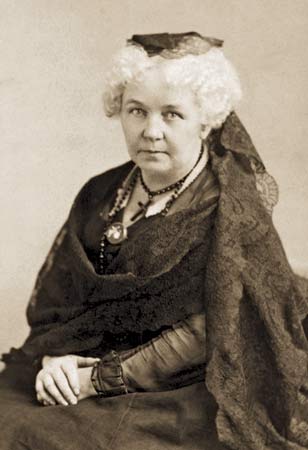
Elizabeth Cady Stanton was an American writer and activist who was a leader of the women's rights movement in the U.S. during the mid- to late-19th century. She was the main force behind the 1848 Seneca Falls Convention, the first convention to be called for the sole purpose of discussing women's rights, and was the primary author of its Declaration of Sentiments. Her demand for women's right to vote generated a controversy at the convention but quickly became a central tenet of the women's movement. She was also active in other social reform activities, especially abolitionism.
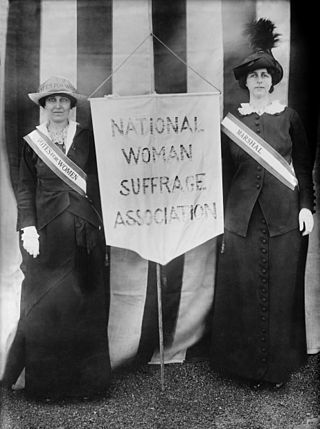
The National Woman Suffrage Association (NWSA) was formed on May 15, 1869, to work for women's suffrage in the United States. Its main leaders were Susan B. Anthony and Elizabeth Cady Stanton. It was created after the women's rights movement split over the proposed Fifteenth Amendment to the U. S. Constitution, which would in effect extend voting rights to black men. One wing of the movement supported the amendment while the other, the wing that formed the NWSA, opposed it, insisting that voting rights be extended to all women and all African Americans at the same time.

The National American Woman Suffrage Association (NAWSA) was an organization formed on February 18, 1890, to advocate in favor of women's suffrage in the United States. It was created by the merger of two existing organizations, the National Woman Suffrage Association (NWSA) and the American Woman Suffrage Association (AWSA). Its membership, which was about seven thousand at the time it was formed, eventually increased to two million, making it the largest voluntary organization in the nation. It played a pivotal role in the passing of the Nineteenth Amendment to the United States Constitution, which in 1920 guaranteed women's right to vote.

Women's suffrage, or the right to vote, was established in the United States over the course of more than half a century, first in various states and localities, sometimes on a limited basis, and then nationally in 1920 with the ratification of the 19th Amendment to the United States Constitution.

Harriot Eaton Blatch was an American writer and suffragist. She was the daughter of pioneering women's rights activist Elizabeth Cady Stanton.

The Women's Loyal National League, also known as the Woman's National Loyal League and other variations of that name, was formed on May 14, 1863, to campaign for an amendment to the U.S. Constitution that would abolish slavery. It was organized by Elizabeth Cady Stanton, its president, and Susan B. Anthony, its secretary. In the largest petition drive in the nation's history up to that time, the League collected nearly 400,000 signatures on petitions to abolish slavery and presented them to Congress. Its petition drive significantly assisted the passage of the Thirteenth Amendment, which ended slavery in the U.S. The League disbanded in August 1864 after it became clear that the amendment would be approved.
The American Woman Suffrage Association (AWSA) was a single-issue national organization formed in 1869 to work for women's suffrage in the United States. The AWSA lobbied state governments to enact laws granting or expanding women's right to vote in the United States. Lucy Stone, its most prominent leader, began publishing a newspaper in 1870 called the Woman's Journal. It was designed as the voice of the AWSA, and it eventually became a voice of the women's movement as a whole.

The American Equal Rights Association (AERA) was formed in 1866 in the United States. According to its constitution, its purpose was "to secure Equal Rights to all American citizens, especially the right of suffrage, irrespective of race, color or sex." Some of the more prominent reform activists of that time were members, including women and men, blacks and whites.
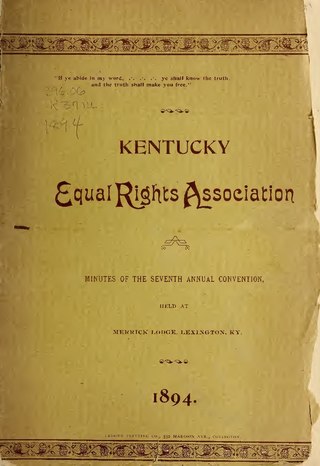
Kentucky Equal Rights Association (KERA) was the first permanent statewide women's rights organization in Kentucky. Founded in November 1888, the KERA voted in 1920 to transmute itself into the Kentucky League of Women Voters to continue its many and diverse progressive efforts on behalf of women's rights.

The College Equal Suffrage League (CESL) was an American woman suffrage organization founded in 1900 by Maud Wood Park and Inez Haynes Irwin, as a way to attract younger Americans to the women's rights movement. The League spurred the creation of college branches around the country and influenced the actions of other prominent groups such as National American Woman Suffrage Association (NAWSA).

The New England Woman Suffrage Association (NEWSA) was established in November 1868 to campaign for the right of women to vote in the U.S. Its principal leaders were Julia Ward Howe, its first president, and Lucy Stone, who later became president. It was active until 1920, when suffrage for women was secured by the Nineteenth Amendment to the U.S. Constitution.
This timeline highlights milestones in women's suffrage in the United States, particularly the right of women to vote in elections at federal and state levels.
History of Woman Suffrage is a book that was produced by Elizabeth Cady Stanton, Susan B. Anthony, Matilda Joslyn Gage and Ida Husted Harper. Published in six volumes from 1881 to 1922, it is a history of the women's suffrage movement, primarily in the United States. Its more than 5700 pages are the major source for primary documentation about the women's suffrage movement from its beginnings through the ratification of the Nineteenth Amendment to the U.S. Constitution, which enfranchised women in the U.S. in 1920. Written from the viewpoint of the wing of the movement led by Stanton and Anthony, its coverage of rival groups and individuals is limited.

Women's suffrage was established in the United States on a full or partial basis by various towns, counties, states and territories during the latter decades of the 19th century and early part of the 20th century. As women received the right to vote in some places, they began running for public office and gaining positions as school board members, county clerks, state legislators, judges, and, in the case of Jeannette Rankin, as a member of Congress.

Caroline Katzenstein was an American suffragist, activist, advocate for equal rights, insurance agent, and author. She was active in the local Philadelphia suffragist movement through the Pennsylvania branch of the National American Woman Suffrage Association and the Equal Franchise Society of Philadelphia. She played a role in the formation of the Congressional Union for Women Suffrage, which later became the National Women's Party. Katzenstein was also active in the movement for equal rights, serving on the Women's Joint Legislative Committee with Alice Paul, and championing the cause for the Equal Rights Amendment. She was the author of Lifting the Curtain: the State and National Woman Suffrage Campaigns in Pennsylvania as I Saw Them (1955).

Women's suffrage in California refers to the political struggle for voting rights for women in the state of California. The movement began in the 19th century and was successful with the passage of Proposition 4 on October 10, 1911. Many of the women and men involved in this movement remained politically active in the national suffrage movement with organizations such as the National American Women's Suffrage Association and the National Woman's Party.
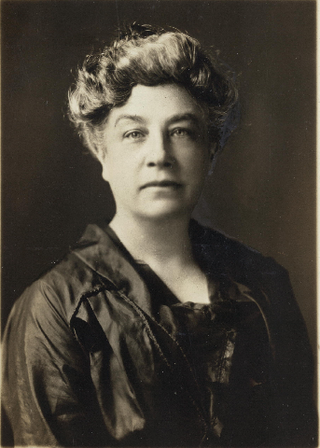
The Southern States Woman Suffrage Conference was a group dedicated to winning voting rights for white women. The group consisted mainly of highly educated, middle and upper class white women of prominent families. They were originally part of the larger National American Woman Suffrage Association (NAWSA), but broke off in 1906. Prominent leaders in the group included Laura Clay and Kate Gordon, who supported and focused on local and state reforms rather than a national amendment. The group applied tactics like the Lost Cause, the belief that the Confederate cause was moral and just, and the Southern strategy, which appealed to white voters by promoting racism.
The West Virginia Equal Suffrage Association (WVESA) was an organization formed on November 29, 1895, at a conference in Grafton, West Virginia. This conference and the subsequent annual conventions were an integral part of the National American Woman Suffrage Association's Southern Committee's work to reach into previously under-represented areas for supporting the women's suffrage movement. The WVESA relied not only on the national association but also worked together with activists from the state's chapter of the Woman's Christian Temperance Union, state chapter of the General Federation of Women's Clubs, and the clubs affiliated with the National Association of Colored Women's Clubs to win the right to vote. Though they lost in a landslide the 1916 referendum to amend the state's constitution for women's suffrage, the group provided the strong push for ratifying the federal amendment in spring 1920 that led to West Virginia becoming the thirty-fourth of the thirty-six states needed. That fall, West Virginia women voted for the first time ever, and the WVESA transformed itself into the League of Women Voters of West Virginia.















